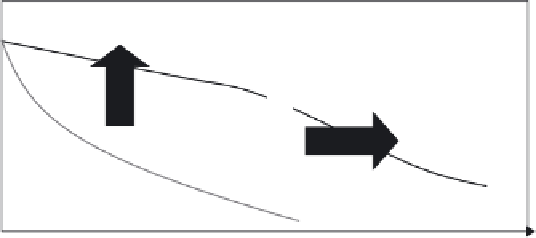Environmental Engineering Reference
In-Depth Information
Post-DNB failure
Δ
H
Burnup
PCMI failure
Burnup
5.10
Clad failure mechanisms (Strasser
et al
., 2010b).
2010b) while VVER high burnup rods only fail through creep burst (due to
very low hydrogen contents in the fuel cladding).
PCMI
- The change in failure mechanism is due to the decrease in pel-
let-cladding gap and the embrittlement of the cladding (due to corrosion
induced hydriding) with increased burnup (Fig. 5.10). The rapid increase
in power leads to nearly adiabatic heating of the fuel pellets, which expand
thermally and may cause fast straining of the surrounding cladding through
PCMI. At this early heat-up stage of the RIA, the cladding material is still
at a fairly low temperature (<650K), and the fast straining imposed by the
expanding fuel pellets may cause a rapid and partially brittle mode of clad
failure (Chung & Kassner, 1998). The survival of a high burnup fuel rod in
a RIA is dependent on the ability of the cladding to resist PCMI, which
depends primarily on the imposed stress and the cladding ductility. The duc-
tility is dependent on the temperature to a large degree, which in turn is
dependent on the pulse width and enthalpy increase of the transient. The
condition of the cladding has a signifi cant effect on the ductility, specifi cally
the alloy composition, microstructure and texture.
In addition, the cladding
hydrogen content - most importantly the hydrogen distribution - has a sig-
nifi cant impact on the PCMI response. More specifi cally, hydride rims/blister
s
and/or radial hydrides
at the clad outer surface may result in a signifi cant
embrittlement effect.
The degree of embrittlement due to precipitation of
hydrides in the cladding is dependent on the amount of hydrogen in excess
of the solubility limit, as well as on size, orientation and distribution of the
hydrides. Hydride-induced embrittlement is a complex matter, and several
mechanisms contribute to the loss of clad strength and ductility (Northwood
& Kosasih, 1983 ).
Hydride blisters can only be formed once the hydrogen content of
the cladding has signifi cantly exceeded the solubility limit and a certain


Search WWH ::

Custom Search